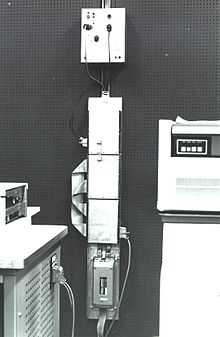Cambridge Ring (computer network)

The Cambridge Ring was an experimental local area network architecture developed at the Cambridge University Computer Laboratory in the mid-late 1970s and early 1980s. It used a ring topology with a theoretical limit of 255 nodes (though such a large number would have badly affected performance), around which cycled a fixed number of packets. Free packets would be "loaded" with data by a machine wishing to send, marked as received by the destination machine, and "unloaded" on return to the sender; thus in principle there could be as many simultaneous senders as packets. The network ran over twin twisted-pair cabling (plus a fibre-optic section).
People associated with the project include Andy Hopper, David Wheeler, Maurice Wilkes, and Roger Needham.[1]
In 2002 the Cambridge University Computer Laboratory launched a graduate society called the Cambridge Computer Lab Ring named after the Cambridge Ring.
See also
References
- ↑ Andrew Hopper; Roger Needham. "The Cambridge Fast Ring Networking System" (PDF). ORL-88-1.
External links
- Cambridge Ring Hardware
- Cambridge Fast Ring
- Cambridge Backbone Ring Hardware
- Cambridge Computer Lab Ring
- "Ring PCB". Relic Archive. University of Cambridge Computer Laboratory. Retrieved 9 April 2011.